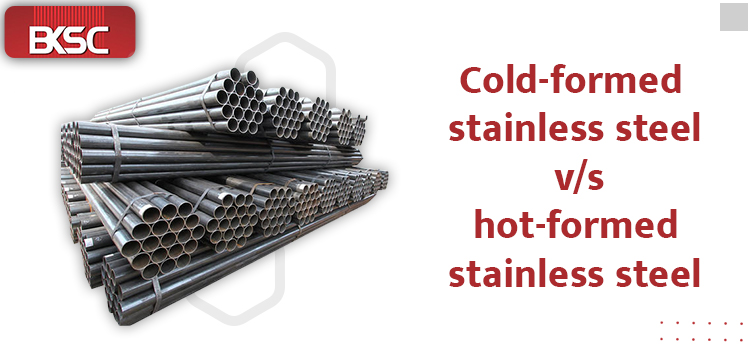When we talk about hot and cold formed stainless steel, a question in our mind is, Is there any chemical that creates the difference between cold and hot formed stainless steel? Most stainless steel materials developed after melting in an EAF (Electric Arc Furnace) in the 1970s. After melting the stainless steel, it turns into a VOD (Vacuum Oxygen Decarburisation) vessel or rarely into an AOD (Argon Oxygen Decarburisation) vessel. This process manages all the impurities, such as carbon, nitrogen, hydrogen, sulfur, etcetera, that may build oxide precipitates. You can refine critical applications, for instance, precipitation hardening alloys and aerospace, but this is a smaller market.
Difference between Cold and hot-formed stainless steel
Chemistry: The introductory chemistry of a particular grade of stainless steel is the same regardless of later it turns into any subsequent shape such as cold or hot rolled or cold drawn shape and hot forged or simple cast. Compared to its base material, stainless steel contains more silicon and chromium. Although cast products become stress-free, their microstructure is dendritic to maintain the required difference between the final bulk solidification and the early solidifying dendrites.
Cold formed: Cold-rolled flare products are unique because they begin at room temperature and have a dimpled surface and finish with thinner material. You may feel astonishing when you see how much it will flatten (turn into quite a slim shape). The increase in strength with hard work can be substantial, especially in delicate materials, as the hard work increase can enhance the power of the full depth. To exemplify, the table from ASTM A666 data shows the substantial change in mechanical properties for 304 from annealed to half hard, i.e., half the absolute maximum possible strength – which would have negligible ductility. Visit the firm of best Cold Work Tool Steel in India to get robust quality products.
Moreover, cold work tool styles are sometimes referred to as high carbon steel consisting of manganese, molybdenum, tungsten, and chromium. As a result, these are hardened and stable by nature. There are three different forms of cold work tool steel as given below:
-
Oil-hardening steel.
-
Air-hardening steels.
-
High-chromium, high-carbon steels.
Hot formed: The development of hot-formed stainless steel is an effortless and straightforward procedure. The molten metal is transferred into the cooled continuous caster from the AOD to create the horizontal slabs from this molten base. This caster is a shield with a black oxide scale made from a chromium layer beneath the weld tints. After that, the sheet is laid down on the surface to maintain its size. Then it is again sent into the furnace to create hot rolling, plate, or coil as the product form. It is also refined to decline its internal stress for annealing above 1000oC.
Alloy steel is prepared with the mixture of two elements (iron and carbon structure) that together extract increased strength, wear resistance, toughness, and hardness. If you want to explore more about the alloy steel material, come to the place of Alloy Steel India. It is conducive to:
-
Enhanced corrosion resistance.
-
Superior strength and hardness.
-
Increased hardenability.


